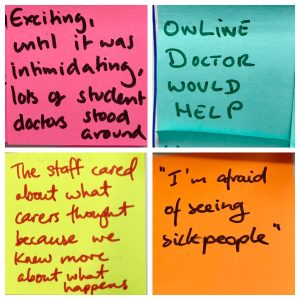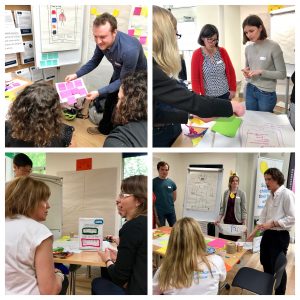Branch
Select your branch
Child Health Hackathon
Child Health Hackathon
“The best and fastest way to innovate, is to collaborate.”
These words from paediatric cardiologist Dr. Anthony Chang capture the motivation behind Innovation Forum Oxford’s Paediatric Innovation Campaign: we want to bring new energy and ideas to the many unsolved challenges in children’s healthcare.
In May 2018 we took another step on this journey in the second instalment of our ACE (Awareness, Connectivity, Exchange) Saturdays program with the Child Health Hackathon. You can read more about part one (Oxford as a future city Design Thinking Workshop) here.
Both of these activities have been supported by Knowledge Exchange and Impact (KEI) funding from the University of Oxford and were designed to bring together individuals in the Oxford ecosystem to share knowledge and experiences to broaden horizons and foster innovative collaboration. The Child Health Hackathon built on the Design Thinking skills participants learnt in the previous workshop and turned the creative design process to the pressing need of innovation in paediatric healthcare.
This year (2018) Innovation Forum Oxford is promoting a focus on paediatric innovation—an area of healthcare that is currently chronically under-served. The US-based Institute for Paediatric Innovation estimates that innovation in children’s medicine currently lags behind adult care by five to ten years. We believe that collaborative innovation is the best way to start redressing the balance. As part of the preparation for the Hackathon, Oxford Innovation Forum team members interviewed clinicians at the John Radcliffe Hospital and local school children at New Marston Primary School—thank-you to all who contributed!

The Hackathon was kicked-off by Thinking of Oscarco-founders David and Hannah Cole who set the context of what on-the-ground innovation in children’s healthcare looks like. David and Hannah founded Thinking of Oscar in memory of their son who died unexpectedly in 2014. The charity has fundraised over £200,000 and supported multiple projects across UK children’s hospitals. You can read more about David and Hannah’s perspective on the day here.
A diverse group of attendees—from paediatricians to software engineers—were supported by Design Thinking expert coaches Alejandro Lecuna and Morganne Graves, who had led the previous IFO ACE Saturday’s workshop on the future of autonomous vehicles. Design teams were formed and each addressed a different challenge focussed on paediatric innovation, such as “redesign the medical procedure experience for children, in a world where most medical processes are designed for adults.”
Perspectives from the paediatric medicine bedside and medical device industry were shared by Dr Janet Craze, consultant paediatrician at the John Radcliffe, and Angela Hobbs, Triteq Managing Director. And together the design teams began interrogating the challenges and extracting themes to start seeking potential users’ views.
After interview training and brainstorming the child heath innovation teams hit the streets of Oxford to interview adults and children about their experiences of the clinical environment as patients or family members.

There was a brief pause for the sharing of interview insights over lunch as teams began to share, select, and hone their design priorities for users. Working in their teams the innovators began to create abstract users that captured as many of the concerns and insights raised in interviews as possible. From here the room started to turn towards design concepts that could address these needs…
“The doctor’s hands were very cold, which I didn’t like. Sometimes it hurts when the doctor puts the instrument to look in my ears too far in.”
-Paediatric patient interviewed by Hackathon participants

Racing against the clock in a day completely packed with ideas and innovation the hackathon teams started to generate design solutions to users’ needs. Smartphone apps, intelligent wrist bands, child friendly pain maps, VR treatment training systems and other innovations began emerging from post-it notes and mind maps.

From here groups began prototyping their designs from simple materials to start working through the practicalities of addressing users’ needs with their design solution. Pipe-cleaners, cardboard, foil and plastic were crafted into all manner of devices—with an emphasis on fun and child-friendly designs. This was also a great opportunity to start creating something a user could hold or interact with and start to give feedback on the successes and pitfalls of the concept.

Design prototypes were then tested on potential users in the room—including fellow innovators as well as clinicians, parents, and children. The feedback this generated then led to rapid iteration and refinement of the designs to better address users’ needs: what worked was kept, while less successful features were refined or removed.
As the day raced on the teams began preparing to pitch their designs to a panel of judges. An impressively diverse range of solutions were showcased by the design teams—ideas that focussed on both parent and child perspectives; concepts to relieve boredom or distract children; aids to assist with hospital navigation and overnight stays; and ways to help less-verbal patients identify their symptoms and concerns. Towards the end of the afternoon the innovators in the room took pause and heard from Jeroen Bergmann, Oxford Biodesign Program Co-Director. Jeroen shared examples of design-driven innovations that have come-out of the Biodesign program before giving his perspective on what it takes to navigate an intervention through the complex path of medical device regulation and clinical trials.

The day was brought to a close with dinner and a drinks reception—discussion flowed and design concepts were test-driven further as we all reflected on a packed and exhausting day that generated some extraordinary ideas. Watch this space for where these designs end-up…










